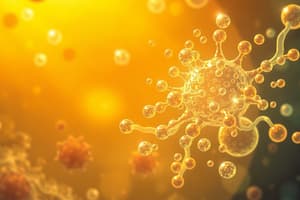Podcast
Questions and Answers
Which type of media has an exact chemical composition that is known and is often used for metabolic experiments?
Which type of media has an exact chemical composition that is known and is often used for metabolic experiments?
- Defined media (correct)
- Complex media
- Differential media
- Selective media
Selective media allow for the growth of all types of microorganisms, distinguishing them based on specific characteristics.
Selective media allow for the growth of all types of microorganisms, distinguishing them based on specific characteristics.
False (B)
What is the assumption made when enumerating microorganisms on a plate regarding the origin of each colony?
What is the assumption made when enumerating microorganisms on a plate regarding the origin of each colony?
Each colony on a plate is a single bacterial or yeast cell in the original liquid.
In immunological methods, an ______ is a molecular marker on the microorganism unique to that microorganism.
In immunological methods, an ______ is a molecular marker on the microorganism unique to that microorganism.
Match the following media types with their respective characteristics:
Match the following media types with their respective characteristics:
Which method offers a more time-efficient measure of microbial activity by assessing a characteristic directly related to it?
Which method offers a more time-efficient measure of microbial activity by assessing a characteristic directly related to it?
The polymerase chain reaction (PCR) is only useful for qualitative detection of specific organisms and cannot be used for quantification.
The polymerase chain reaction (PCR) is only useful for qualitative detection of specific organisms and cannot be used for quantification.
What is the primary limitation of using a medium with >300 colonies for enumeration?
What is the primary limitation of using a medium with >300 colonies for enumeration?
Results from cultures are usually reported in ______, representing colony forming units per milliliter in the original sample.
Results from cultures are usually reported in ______, representing colony forming units per milliliter in the original sample.
Match each term with its correct description within the context of microbial detection:
Match each term with its correct description within the context of microbial detection:
Which of the following statements accurately describes the advantage of molecular biology methods over traditional culturing methods?
Which of the following statements accurately describes the advantage of molecular biology methods over traditional culturing methods?
Complex media are preferred over defined media when conducting metabolic experiments due to their known exact chemical compositions.
Complex media are preferred over defined media when conducting metabolic experiments due to their known exact chemical compositions.
Briefly explain why MacConkey agar is considered a differential medium.
Briefly explain why MacConkey agar is considered a differential medium.
To enumerate microorganisms with a dilution of $10^{-5}$ and a colony count of 50, the CFU/mL in the original sample is ______.
To enumerate microorganisms with a dilution of $10^{-5}$ and a colony count of 50, the CFU/mL in the original sample is ______.
Match the following dilution factors with the corresponding CFU/mL calculation, assuming a plate count of 45 colonies:
Match the following dilution factors with the corresponding CFU/mL calculation, assuming a plate count of 45 colonies:
Which of the following is an example of an indirect method for detecting microorganisms?
Which of the following is an example of an indirect method for detecting microorganisms?
When using serial dilutions to enumerate microorganisms, it is acceptable to count plates with more than 300 colonies for accurate enumeration.
When using serial dilutions to enumerate microorganisms, it is acceptable to count plates with more than 300 colonies for accurate enumeration.
Explain the significance of using both selective and differential media in identifying a specific pathogen in a mixed culture.
Explain the significance of using both selective and differential media in identifying a specific pathogen in a mixed culture.
In PCR, the amplification of DNA or RNA allows for detection of specific ______ even when present in small quantities.
In PCR, the amplification of DNA or RNA allows for detection of specific ______ even when present in small quantities.
Match the following scenarios with the most appropriate type of microbial detection method:
Match the following scenarios with the most appropriate type of microbial detection method:
Which of the following is a disadvantage of using complex media compared to defined media?
Which of the following is a disadvantage of using complex media compared to defined media?
Immunological methods rely on amplifying the genetic material of microorganisms for detection.
Immunological methods rely on amplifying the genetic material of microorganisms for detection.
Explain why culturing is often the first step in identifying microorganisms in food, even with faster methods available.
Explain why culturing is often the first step in identifying microorganisms in food, even with faster methods available.
When performing serial dilutions, a countable range typically falls between ______ and ______ colonies to ensure accuracy.
When performing serial dilutions, a countable range typically falls between ______ and ______ colonies to ensure accuracy.
Match the following descriptions with the appropriate type of culture medium:
Match the following descriptions with the appropriate type of culture medium:
What is the primary advantage of using lateral flow assays in food microbiology?
What is the primary advantage of using lateral flow assays in food microbiology?
Defined media is easier to make compared to complex media due to its simple and known composition.
Defined media is easier to make compared to complex media due to its simple and known composition.
Why is it essential to dilute samples when enumerating microorganisms from a food sample? Explain the rationale.
Why is it essential to dilute samples when enumerating microorganisms from a food sample? Explain the rationale.
The countable range in serial dilutions is typically considered inaccurate if it goes below ______ colonies, as the results can lack statical backing.
The countable range in serial dilutions is typically considered inaccurate if it goes below ______ colonies, as the results can lack statical backing.
When might you prefer to use immunological methods over PCR for detecting a foodborne pathogen?
When might you prefer to use immunological methods over PCR for detecting a foodborne pathogen?
An antibody recognizes the bacterial antigen and amplifies the antigen itself facilitating higher sensitivity.
An antibody recognizes the bacterial antigen and amplifies the antigen itself facilitating higher sensitivity.
A $10^{-3}$ dilution yields 330 colonies. How would you record the plate and why?
A $10^{-3}$ dilution yields 330 colonies. How would you record the plate and why?
While performing PCR, one strand of DNA can be used to create ______ of copies.
While performing PCR, one strand of DNA can be used to create ______ of copies.
Match the method for detecting enumeration of microorganisms with the correct way it helps:
Match the method for detecting enumeration of microorganisms with the correct way it helps:
Regarding the relationship of Molecular Biology and Microbial methods, which statement is true?
Regarding the relationship of Molecular Biology and Microbial methods, which statement is true?
Titratable acidity helps determine how well microbes grew in the atmosphere.
Titratable acidity helps determine how well microbes grew in the atmosphere.
Is MacConkey agar selective or differential?
Is MacConkey agar selective or differential?
An antibody is considered a ______ marker.
An antibody is considered a ______ marker.
Match the following reagents to the appropriate media usage:
Match the following reagents to the appropriate media usage:
Flashcards
Microorganism Detection
Microorganism Detection
Methods to find, name, and count microbes in food samples.
Culturing Microorganisms
Culturing Microorganisms
Growing microorganisms in a controlled environment to study them.
Defined Media
Defined Media
A medium where the exact chemical components are known.
Complex Media
Complex Media
Signup and view all the flashcards
Selective Media
Selective Media
Signup and view all the flashcards
Differential Media
Differential Media
Signup and view all the flashcards
Enumeration of Microorganisms
Enumeration of Microorganisms
Signup and view all the flashcards
Colony Forming Unit (CFU)
Colony Forming Unit (CFU)
Signup and view all the flashcards
Polymerase Chain Reaction (PCR)
Polymerase Chain Reaction (PCR)
Signup and view all the flashcards
Antigen
Antigen
Signup and view all the flashcards
Antibody
Antibody
Signup and view all the flashcards
Indirect Methods
Indirect Methods
Signup and view all the flashcards
Study Notes
- Methods for detecting, identifying, and counting microorganisms in food include culturing, molecular biology, immunological methods, and others.
Culturing Microorganisms
- Involves growing organisms on a suitable medium in a petri dish.
- Different organisms require different growth conditions
- Media types, growth temperatures, and atmospheres influence microorganism growth.
- Culturing can be selective versus differential and allows for enumeration and biochemical testing
Chemically Defined vs Complex Media
- Defined media have an exact known chemical composition and are used for metabolic experiments, but are more labor-intensive to make.
- Complex media's exact chemical composition is not known but it contains ingredients like casein digest, soybean digest, and yeast extracts, making it easier to prepare.
Selective and Differential Media
- Media can be both selective and differential.
- Selective media allows only certain bacteria to grow.
- Differential media allows many bacteria to grow, but distinguishes characteristics, like blood agar for bacteria that break down red blood cells
- MacConkey agar allows only gram-negative bacteria to grow and identifies lactose-fermenting bacteria.
Enumeration of Microorganisms
- Grow organisms in a suitable medium at different dilutions and count colonies after a growth period, typically 1-3 days, and usually 1 mL of media is plated.
- Each colony on a plate is assumed to be a single bacterial or yeast cell from the original liquid.
- Countable range is 30-300 colonies
- Less than 30 colonies allows for the reporting of estimated plate counts
- More than 300 colonies is too numerous to count.
- Results are reported in CFU (colony forming units)/mL in the original sample.
Molecular Biological Methods
- Polymerase chain reaction is used to detect DNA or RNA of specific organisms, can be used for identification or quantification, and is faster than culturing methods.
Immunological Methods
- Antigens are molecular markers unique to microorganisms.
- Antibodies recognize molecular markers
- Lateral flow assays (qualitative) and ELISA (quantitative) are used.
Other Detection Methods
- Indirect methods measure a characteristic related to microbial activity.
- Titratable acidity in milk is an example.
Studying That Suits You
Use AI to generate personalized quizzes and flashcards to suit your learning preferences.




